Abstract
Fruits of citrus cultivars contain bioflavonoids and some other important secondary metabolites in pharmaceutical and nutritional industries. The present experiment was designed to investigate the correlation between the content of flavonoid components like naringin, hesperidin, and neohesperidin of the scions fruits and the same parameters in rootstocks fruits. Six-year-old trees including four citrus cultivars of ‘Moro’, ‘Mars’, ‘Salustiana’, and ‘Italian’ which were previously grafted on the four different rootstocks including ‘Yuzu’, ‘Shelmahalleh’, ‘Citromelo’, and ‘Sour orange’ were selected as experimental trees. The content of the mentioned flavonoids was investigated in the peel and pulp of the fruits of both scions and rootstocks. The results showed that the measured parameters were significantly influenced by scions, rootstocks, and tissues. Based on the obtained results, it can be suggested that the accumulation of chemicals in citrus fruit depends on genetic and inherent abilities of the scion, more than what was previously believed, while the rootstock can also play an important role in the accumulation of these substances.






Similar content being viewed by others
References
Abeysinghe DC, Li X, Sun C, Zhang W, Zhou C, Chen K (2007) Bioactive compounds and antioxidant capacities in different edible tissues of citrus fruit of four species. Food Chem 104:1338–1344
Agusti M, Almeda V, Juan M, Mesejo C, Martinez-Fuentes A (2003) Rootstock influence on the incidence of rind breakdown in Navelate sweet orange. J Hortic Sci Biotechnol 78(4):554–558
Angell G (2004) Effect of rootstock and inter-stock grafting of lemon trees (Citrus lemon) on the flavonoid content. J Agric Food Chem 52(2):324–331
Benjamin G, Tietel Z, Porat R (2013) Effects of rootstock/scion combinations on the flavor of citrus fruit. J Agric Food Chem 61(47):11286–11294
Cano A, Bermejo A (2011) Influence of rootstock and cultivar on bioactive compounds in citrus peels. J Sci Food Agric 91(9):1702–1711
Castle WS (1987) Citrus rootstocks. In: Rom RC, Carlson RF (eds) Rootstocks for fruit crops. Wiley, New York, pp 361–399
Chang CC, Yang MH, Wen HM, Chern JC (2002) Estimation of total flavonoid content in propolis by two complementary colorimetric methods. J Food Drug Anal 10(3):178–182
Chau CF, Huang YL (2003) Comparison of the chemical composition and physicochemical properties of different fibers prepared from the peel of Citrus sinensis L. Cv. Liucheng. J Agric Food Chem 51(9):2615–2618
Economides CV, Grogoriou C (1993) Growth, yield, and fruit quality of nucellar ‘Frost Marsh’ grapefruit on fifteen rootstocks in Cyprus. J Am Soc Hortic Sci 118:326–329
Fluckiger FA, Hanbury D (1986) Pharmacographia—a history of the principal drugs of vegetable origin. International Book Distributors, Delhi, pp 104–105
Furtado AF, Nunes MA, Ribeiro MH (2012) Hesperidinase encapsulation towards hesperitin production targeting improved bioavailability. J Mol Rec 25(11):595–603
Garcia-Sanchez F, Jifon JL, Carvajal M, Syvertsen JP (2002) Gas exchange, chlorophyll and nutrient contents in relation to Na and Cl accumulation in ‘Sunburst’ mandarin grafted on different rootstocks. Plant Sci 162:705–712
Garg A, Garg S, Zanereld LJD, Singla AK (2001) Chemistry and pharmacology of the citrus bioflavonoid hesperidin. Phytother Res 15(8):665–699
Gil-Izquierdo A, Riquelme MT, Porras I, Ferreres F (2004) Effect of the rootstock and interstock grafted in lemon tree (Citrus limon (L.) Burm.) on the flavonoid content of lemon juice. J Agric Food Chem 52(2):324–331
Gonçalves B, Moutinho-Pereira J, Santos A, Silva AP, Bacelar E, Correia C, Rosa E (2005) Scion-rootstock interaction affects the physiology and fruit quality of sweet cherry. Tree Physiol 26(1):93–104
Hui YH (2006) Handbook of fruits and fruit processing, chapter 19. Oranges and citrus juices. Blackwell Publishing, New York, pp 309–348
Janick J, Moore JN (1975) Advances in fruit breeding. Purdue University Press, West Lafayette, p 623
Keford J, Chandler B (1995) The influence rootstock and interstock on the composition of orange with special reference to bitter principle. J Agric Res 12(1):56–68
Kviklys D, Liaudanskas M, Janulis V, Viškelis P, Rubinskienė M, Lanauskas J, Uselis N (2014) Rootstock genotype determines phenol content in apple fruits. Plant Soil Environ 60(5):234–240
Lim M, Te-chato S (2006) The influence of some citrus rootstock species on yield, fruit quality and compatible characteristics of Necked orange (Citrus reticulata Blanco cv. Necked Orange) and Shogun (Citrus reticulata Blanco cv. Shogun). Songklanakarin J Sci Technol 28:515–530
Mäkynen K, Jitsaardkul S, Tachasamran P, Sakai N, Puranachoti S, Nirojsinlapachai N, Adisakwattana S (2013) Cultivar variations in antioxidant and antihyperlipidemic properties of pomelo pulp (Citrus grandis [L.] Osbeck) in Thailand. Food Chem 139(1):735–743
Manthey JA, Grohmann K (1996) Concentrations of hesperidin and other orange peel flavonoids in citrus processing byproducts. J Agric Food Chem 44(3):811–814
Pandjaitan N, Howard LR, Morelock T, Gil MI (2005) Antioxidant capacity and phenolic content of spinach as affected by genetics and maturation. J Agric Food Chem 53(22):8618–8623
Peterson JJ, Beecker GR, Bhagwat SA, Dwyer JT, Gebhardi E, Harytowitz DB, Holden JM (2006) Flavenones in grapefruit, lemons, limes: a complication and review of the data from the analytical literature. J Food Comp Anal 19:74–80
Slinkard K, Singleton VL (1977) Total phenol analysis: automation and comparison with manual methods. Am J Enol Viticulture 28:49–55
Wheaton TA, Whitney JD, Castle WS, Tucker DPH (1986) Tree spacing and rootstock affect growth yield, fruit quality, and freeze damage of young ‘Hamlin’ and ‘Valencia’ orange trees. Proc Fla State Hortic Soc 120(5):861–870
Ye XQ, Chen JC, Liu DH, Jiang P, Shi J, Xue S, Kakuda Y (2011) Identification of bioactive composition and antioxidant activity in young mandarin fruits. Food Chem 124(4):1561–1566
Zhang YM, Zhou ZQ, Sun YJ, Shen Y, Zhong LZ et al (2012) Simultaneous determination of 18 flavonoids in citrus fruits by high-performance liquid chromatography. Sci Agric Sin 45:3558–3565
Acknowledgements
We would like to thank Gorgan University of Agricultural Sciences and Natural Resources for this research financial support.
Author information
Authors and Affiliations
Corresponding author
Additional information
Communicated by M. H. Walter.
Rights and permissions
About this article
Cite this article
Hemmati, N., Ghasemnezhad, A., Moghaddam, J.F. et al. Variation in the content of bioflavonoids of orange as affected by scion, rootstock, and fruit part. Acta Physiol Plant 40, 83 (2018). https://doi.org/10.1007/s11738-018-2648-1
Received:
Revised:
Accepted:
Published:
DOI: https://doi.org/10.1007/s11738-018-2648-1




